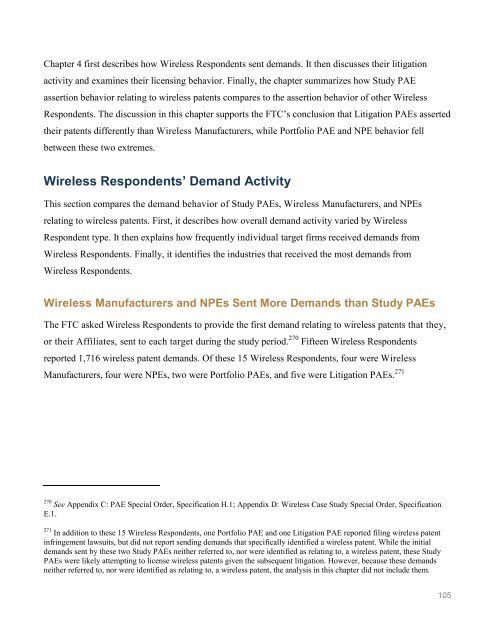You also want an ePaper? Increase the reach of your titles
YUMPU automatically turns print PDFs into web optimized ePapers that Google loves.
Chapter 4 first describes how Wireless Respondents sent demands. It then discusses their litigation<br />
activity and examines their licensing behavior. Finally, the chapter summarizes how Study PAE<br />
assertion behavior relating to wireless patents compares to the assertion behavior of other Wireless<br />
Respondents. The discussion in this chapter supports the FTC’s conclusion that Litigation PAEs asserted<br />
their patents differently than Wireless Manufacturers, while Portfolio PAE and NPE behavior fell<br />
between these two extremes.<br />
Wireless Respondents’ Demand <strong>Activity</strong><br />
This section compares the demand behavior of Study PAEs, Wireless Manufacturers, and NPEs<br />
relating to wireless patents. First, it describes how overall demand activity varied by Wireless<br />
Respondent type. It then explains how frequently individual target firms received demands from<br />
Wireless Respondents. Finally, it identifies the industries that received the most demands from<br />
Wireless Respondents.<br />
Wireless Manufacturers and NPEs Sent More Demands than Study PAEs<br />
The FTC asked Wireless Respondents to provide the first demand relating to wireless patents that they,<br />
or their Affiliates, sent to each target during the study period. 270 Fifteen Wireless Respondents<br />
reported 1,716 wireless patent demands. Of these 15 Wireless Respondents, four were Wireless<br />
Manufacturers, four were NPEs, two were Portfolio PAEs, and five were Litigation PAEs. 271<br />
270<br />
See Appendix C: PAE Special Order, Specification H.1; Appendix D: Wireless Case Study Special Order, Specification<br />
E.1.<br />
271<br />
In addition to these 15 Wireless Respondents, one Portfolio PAE and one Litigation PAE reported filing wireless patent<br />
infringement lawsuits, but did not report sending demands that specifically identified a wireless patent. While the initial<br />
demands sent by these two Study PAEs neither referred to, nor were identified as relating to, a wireless patent, these Study<br />
PAEs were likely attempting to license wireless patents given the subsequent litigation. However, because these demands<br />
neither referred to, nor were identified as relating to, a wireless patent, the analysis in this chapter did not include them.<br />
105


